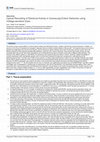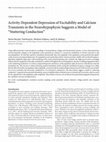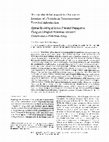Papers by Brian m. Salzberg
Discontinuities in Action Potential Propagation Along Chains of Single Ventricular Myocytes in Culture: Multiple Site Optical Recording of Transmembrane Voltage (MSORTV) Suggests Propagation Delays at the Junctional Sites Between Cells
The Biological Bulletin, 1992
Neuron, 2013
The Brain Research through Advancing Innovative Neurotechnologies (BRAIN) Initiative has focused ... more The Brain Research through Advancing Innovative Neurotechnologies (BRAIN) Initiative has focused scientific attention on the necessary tools to understand the human brain and mind. Here, we outline our collective vision for what we can achieve within a decade with properly targeted efforts and discuss likely technological deliverables and neuroscience progress.

Journal of Visualized Experiments
The enteric nervous system (ENS) is a self-contained network with identified functions, capable o... more The enteric nervous system (ENS) is a self-contained network with identified functions, capable of performing complex behaviors in isolation. Its neurons (10 to 25 μm in diameter) are arranged in plexuses that are confined to distinct planes of the gut wall 1 ; the myenteric plexus can be found between the longitudinal and circular muscle layers, and the submucous plexus between the circular muscle layer and the mucosa. Since the effector systems for these plexuses (transporting epithelium, endocrine cells, immune elements, blood vessels and smooth muscle) are also contained within the gut wall, semi-intact preparations can be dissected that preserve individual components of different reflex pathways. The behavior of the effector systems is controlled by the submucous and myenteric plexuses acting in concert. Therefore, detailed knowledge of synaptic interactions within and between ganglia, and of communication between the plexuses, is essential for understanding normal gastrointestinal function. The ENS, as an intact nervous system, is a unique experimental model in which one can correlate molecular and cellular events with the electrical behavior of the neuronal network and its physiological outputs. Because of the quasi-two-dimensional organization of its plexuses, the ENS is particularly well suited for the study of neural networks using multiple site optical recording techniques that employ voltage-sensitive dyes 2,7,8,9. We will illustrate here the use of a relatively new naphthylstyryl-pyridinium dye (di-4-ANEPPDHQ) 3 that offers multiple advantages over its predecessors, including very low phototoxicity, slow rate of internalization, and remarkable chemical stability. When used in conjunction with a camera that permits sub-millisecond time resolution, this dye allows us to monitor the electrical activity of all the neurons in the field of view with a maximal spatial resolution of~2.5 μm at 100X magnification. At lower magnification (10X or 20X), the sacrifice of single-cell resolution is compensated by a gain in perspective, revealing the intricacies of the inter-ganglionic circuitry.

Optical studies of excitation and secretion at vertebrate nerve terminals
Society of General Physiologists series, 1986
Optical methods that employ potential sensitive molecular probes are shown to monitor rapid chang... more Optical methods that employ potential sensitive molecular probes are shown to monitor rapid changes in membrane potential from populations of nerve terminals in the neurohypophyses of amphibia and mammals. Ca++ and Na+ contributions to the action potential are demonstrated and, in the mouse, variations in light scattering are detected following membrane potential changes known to trigger the release of peptide hormones. Calcium antagonists such as Cd++, Mn++, Co++, and Ni++ block an after-hyperpolarization in the frog that we attribute to the effect of a calcium mediated potassium conductance. Block of sodium and potassium currents with TTX and TEA reveals a pure calcium action potential which is eliminated by 0.5 mN Cd++. In the mouse, the magnitude of the light scattering signal depends upon the frequency of stimulation and the extracellular concentration of Ca++, as well as on the presence of secretagogues such as 4-aminopyridine. A part of this intrinsic optical signal that seems to be correlated with neuropeptide release is blocked by inorganic calcium antagonists, while a faster component related to the action potential itself remains. The weak wavelength dependence of the light scattering signal, contrasted with the strong wavelength dependence of the extrinsic absorption signal provided by linear potentiometric probes (e.g., merocyanines), may permit one to monitor simultaneoulsy, in a stained preparation, the voltage changes in the nerve terminals and the release of secretory products. The inherently fast responses of the two optical measurements may then improve our ability to resolve early events in the coupling of excitation to secretion. Supported in part by USPHS grant NS 16824.

Multiple-Site Optical Recording of Membrane Potential from a Salivary Gland Interaction of Synaptic and Electrotonic Excitation
The interaction between synaptic and electrotonic excitation of cells from the salivary gland of ... more The interaction between synaptic and electrotonic excitation of cells from the salivary gland of the snail Helisoma trivolvis was studied using a voltage-sensitive merocyanine dye. Linear and square photodiode matrix arrays were used to record simultaneously the response to neuronal stimulation of 15-25 separate regions of the gland. Laterally opposed acini exhibited highly synchronous electrical activity, which suggested a correspondingly high degree of electrical coupling. In the longitudinal direction, coupling appeared weaker. The onset ofdepolarization after neuronal stimulation was progressively delayed along the longitudinal gland axis, in agreement with the measured conduction velocity of the presynaptic nerve spike. In most instances, neuronal stimulation directly activated a regenerative gland response (action potential) at thejunction between the anterior and central duct. Excitation of distal gland regions was usually mediated by electrotonic spread from active, more pro...

Caffeine Interaction with Fluorescent Calcium Indicator Dyes
We report that caffeine, in millimolar concentrations, interacts strongly with four common calciu... more We report that caffeine, in millimolar concentrations, interacts strongly with four common calcium indicator dyes: mag-fura-2, magnesium green, fura-2, and fluo-3. Fluorescence intensities are either noticeably enhanced (mag-fura-2, fura-2) or diminished (magnesium green, fluo-3). The caffeine-induced changes in the fluorescence spectra are clearly distinct from those of metal ion binding at the indicator chelation sites. Binding affinities for calcium of either mag-fura-2 or magnesium green increased only slightly in the presence of caffeine. Caffeine also alters the fluorescence intensities of two other fluorescent dyes lacking a chelation site, fluorescein and sulforhodamine 101, implicating the fluorophore itself as the interaction site for caffeine. In the absence of caffeine, variation of solution hydrophobicity by means of water/dioxane mixtures yielded results similar to those for caffeine. These observations suggest that hydrophobic substances, in general, can alter dye flu...

Long-term optical recording of patterns of electrical activity in ensembles of cultured Aplysia neurons
1. Left upper quadrant (LUQ) cells isolated from the abdomi-nal ganglion of Aplysia were maintain... more 1. Left upper quadrant (LUQ) cells isolated from the abdomi-nal ganglion of Aplysia were maintained in culture to study how the cellular and synaptic properties of individual neurons contrib-ute to the generation of patterns of electrical activity by neuronal ensembles. 2. Conventional microelectrodes were used to examine the spiking characteristics of individually cultured LUQ cells in vitro and to characterize their synaptic interactions. 3. In vitro, in contrast to in situ, LUQ neurons innervate other LUQ neurons. Intracellular recordings from pairs of LUQ cells showed that the prevalent type of postsynaptic potential was purely inhibitory. The other type of response was a dual-action postsynaptic potential, with inhibition followed by a delayed, slow excitation. 4. We established a set of criteria for the use of multiple-site
Multiple Site Optical Recording of Transmembrane Voltage
Excitation and secretion at the nerve terminals of vertebrates: optical measurements with and without voltage-sensitive dyes
Society of General Physiologists series, 1989
Optical Recording With Single Cell Resolution from a Simple Mammalian Nervous System: Electrical Activity in Ganglia from the Submucous Plexus of the Guinea-Pig Ileum
The Biological Bulletin
The 3 π Mass Spectrum in the Reaction π − p → p π + π − π − at 13 and 20 GeV/ c
Physical Review Letters, 1968
ABSTRACT

Dendritic origin of late events in optical recordings from salamander olfactory bulb
Journal of neurophysiology, 1992
1. Optical recordings of membrane-potential changes were used to characterize the origin and prop... more 1. Optical recordings of membrane-potential changes were used to characterize the origin and properties of the electrical signals from the dendritic level in slices of the salamander olfactory bulb. 2. The optical events were correlated with field-potential waves recorded simultaneously. Both responses exhibited patterns similar to those found in other species. 3. Orthodromic stimulation evoked a compound action potential in the olfactory nerve fibers, followed by two additional principal waves (N1 and N2). These field-potential waves reflected excitatory postsynaptic potentials at the primary mitral/tufted and granule cell dendrites, respectively. 4. Extrinsic optical signals from horizontal slices stained with the pyrazo-oxonal dye RH-155 showed a characteristic sequence of depolarizing and hyperpolarizing events. All of the signals exhibited a wavelength dependence expected for this dye and were abolished in the presence of high K+ in the bath. 5. According to their time courses,...

Using millisecond time-resolved optical recordings of transmembrane voltage and intraterminal cal... more Using millisecond time-resolved optical recordings of transmembrane voltage and intraterminal calcium, we have determined how activity-dependent changes in the population action potential are related to a concurrent modulation of calcium transients in the neurohypophysis. We find that repetitive stimulation dramatically alters the amplitude of the population action potential and significantly increases its temporal dispersion. The population action potentials and the calcium transients exhibit well correlated frequencydependent amplitude depression, with broadening of the action potential playing only a limited role. High-speed camera recordings indicate that the magnitude of the spike modulation is uniform throughout the neurohypophysis, thereby excluding propagation failure as the underlying mechanism. In contrast, temporal dispersion and latency of the population spike do increase with distance from the stimulation site. This increase is enhanced during repeated stimulation and by raising the stimulation frequency. Changes in Ca influx directly affect the decline in population spike amplitude, consistent with electrophysiological measurements of the local loss of excitability in nerve terminals and varicosities, mediated by a Ca-activated K conductance. Our observations suggest a model of "stuttering conduction": repeated action potential stimulation causes excitability failures limited to nerve terminals and varicosities, which account for the rapid decline in the population spike amplitude. These failures, however, do not block action potential propagation but generate the cumulative increases in spike latency.
Nuclear Physics B - NUCL PHYS B, 1970
Data from the reaction pi-p --> ppi+pi-pi- at 13 and 20 GeV/c are used in a comparison of the ... more Data from the reaction pi-p --> ppi+pi-pi- at 13 and 20 GeV/c are used in a comparison of the channel pi-p --> pvarrho0pi- with a Double-Regge-Pole Model (DRPM) which includes both pi- and varrho-trajectory exchanges. A similar comparison is made for the channel pi-p --> pf0pi-. Excellent agreement between the model and the data is obtained. work supported in part by the United States Atomic Energy Commission.

The Journal of General Physiology, 1996
Modulation of the amount of neuropeptide released from a neurosecretory tissue may be achieved by... more Modulation of the amount of neuropeptide released from a neurosecretory tissue may be achieved by different means. These include alterations in the quantity secreted from each active nerve terminal or in the actual number of terminals activated. From the vertebrate hypothalamus, magnocellular neurons project their axons as bundles of fibers through the median eminence and infundibular stalk to arborize extensively and terminate in the neurohypophysis, where the neurohypophysial peptides and proteins are released into the circulation by a Ca-dependent mechanism. Elevating [Ca2+]o increases the magnitude of an intrinsic optical change in the neurohypophysial terminals that is intimately related to the quantity of neuropeptide released. Similarly, the addition of micromolar concentrations of 4-aminopyridine to the bathing solution enhances this change in large angle light scattering. However, we show here that, while these effects are superficially similar, they reflect different mecha...
Physical Review Letters, 1971
A study of the A1- density-matrix elements shows that s-channel helicity is not conserved in the ... more A study of the A1- density-matrix elements shows that s-channel helicity is not conserved in the process pi-p-->A1-p between 5 and 25 GeVc. Instead the A1- density-matrix elements have simple behavior in the t-channel helicity frame. A new analysis of the A1- cross section as a function of the incident pi- momentum is also presented.
The reaction pi-p --> ppi+pi-pi-pi° at 20 GeV/c
Nuclear Physics B - NUCL PHYS B, 1972
Data from the reaction pi-p --> ppi+pi-pi-pi° at 20 GeV/c are studied in detail. The cross sec... more Data from the reaction pi-p --> ppi+pi-pi-pi° at 20 GeV/c are studied in detail. The cross sections for the production of varrho, nu° and omega° mesons, and Delta (1236) isobars are estimated. The channels peta°pi- and pomega°pi- are compared with a double Regge pole model calculation and the cross section for the contribution from individual diagrams calculated. The data are divided by the method of longitudinal phase space and each category examined in detail. A search is made for possible production of pi-(1700), A01 and A20 and upper limits placed on their cross sections. Present address: Department of Physiology, Yale University, New Haven, Connecticut 06521.
Calcium channels that are required for secretion from intact nerve terminals of vertebrates are sensitive to ω-conotoxin and relatively insensitive to dihydropyridines. Optical studies with and without voltage-sensitive dyes
The Journal of General Physiology










Uploads
Papers by Brian m. Salzberg